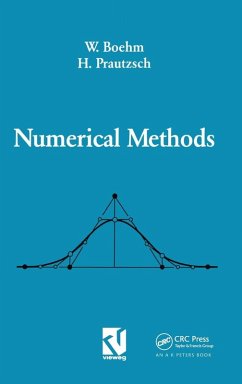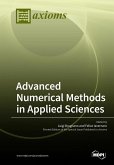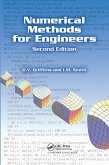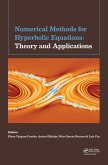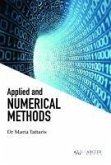- Gebundenes Buch
- Merkliste
- Auf die Merkliste
- Bewerten Bewerten
- Teilen
- Produkt teilen
- Produkterinnerung
- Produkterinnerung
This book is written for engineers and other practitioners using numerical methods in their work and serves as a textbook for courses in applied mathematics and numerical analysis.
Andere Kunden interessierten sich auch für
![Advanced Numerical Methods in Applied Sciences Advanced Numerical Methods in Applied Sciences]() Advanced Numerical Methods in Applied Sciences90,99 €
Advanced Numerical Methods in Applied Sciences90,99 €![Numerical Methods Numerical Methods]() Numerical Methods59,99 €
Numerical Methods59,99 €![Numerical and Analytical Methods with MATLAB for Electrical Engineers Numerical and Analytical Methods with MATLAB for Electrical Engineers]() William BoberNumerical and Analytical Methods with MATLAB for Electrical Engineers170,99 €
William BoberNumerical and Analytical Methods with MATLAB for Electrical Engineers170,99 €![Numerical Methods for Engineers Numerical Methods for Engineers]() D. Vaughan GriffithsNumerical Methods for Engineers219,99 €
D. Vaughan GriffithsNumerical Methods for Engineers219,99 €![Numerical Methods for Inverse Problems Numerical Methods for Inverse Problems]() Numerical Methods for Inverse Problems167,99 €
Numerical Methods for Inverse Problems167,99 €![Numerical Methods for Hyperbolic Equations Numerical Methods for Hyperbolic Equations]() Numerical Methods for Hyperbolic Equations326,99 €
Numerical Methods for Hyperbolic Equations326,99 €![Applied and Numerical Methods Applied and Numerical Methods]() Maria TattarisApplied and Numerical Methods157,99 €
Maria TattarisApplied and Numerical Methods157,99 €-
-
-
This book is written for engineers and other practitioners using numerical methods in their work and serves as a textbook for courses in applied mathematics and numerical analysis.
Produktdetails
- Produktdetails
- Verlag: A K Peters/CRC Press
- Seitenzahl: 198
- Erscheinungstermin: 18. Dezember 2020
- Englisch
- Abmessung: 240mm x 161mm x 15mm
- Gewicht: 467g
- ISBN-13: 9781138413177
- ISBN-10: 1138413178
- Artikelnr.: 60016603
- Herstellerkennzeichnung
- Libri GmbH
- Europaallee 1
- 36244 Bad Hersfeld
- gpsr@libri.de
- Verlag: A K Peters/CRC Press
- Seitenzahl: 198
- Erscheinungstermin: 18. Dezember 2020
- Englisch
- Abmessung: 240mm x 161mm x 15mm
- Gewicht: 467g
- ISBN-13: 9781138413177
- ISBN-10: 1138413178
- Artikelnr.: 60016603
- Herstellerkennzeichnung
- Libri GmbH
- Europaallee 1
- 36244 Bad Hersfeld
- gpsr@libri.de
Boehm , Wolfgang
Preface
I FUNDAMENTAL CONCEPTS
1 Algorithms and Error Propagation
1.1 Algorithms
1.2 The Implementation of Algorithms
1.3 Judging an Algorithm
1.4 Notes and Exercises
2 Matrices
2.1 Notations
2.2 Products of Matrices
2.3 Falk's Scheme
2.4 Rank and Determinant
2.5 Norm and Convergence
2.6 Notes and Exercises
II LINEAR EQUATIONS AND INEQUALITIES
3 Gaussian Elimination
3.1 Backward Substitution
3.2 Gaussian Elimination
3.3 Pivoting
3.4 Notes and Exercises
4 The LU Factorization
4.1 The LU Factorization of A
4.2 LU Factorization with Pivoting
4.3 Systems of Linear Equations
4.4 Notes and Exercises
5 The Exchange Algorithm
5.1 Exchanging Variables
5.2 Scheme and Algorithm
5.3 Inversion
5.4 Linear Equations
5.5 Notes and Exercises
6 The Cholesky Factorization
6.1 Symmetrical Factorization
6.2 Existence and Uniqueness
6.3 Symmetric Systems of Linear Equations
6.4 Iterative Refinement
6.5 Notes and Exercises
7 The QU Factorization
7.1 The Householder Transformation
7.2 The Householder Algorithm
7.3 Systems of Linear Equations
7.4 Notes and Exercises
8 Relaxation Methods
8.1 Coordinate Relaxation
8.2 Convergence for Diagonally Dominant Matrices
8.3 The Minimum Problem
8.4 Convergence for Symmetric, Positive Definite Matrices
8.5 Geometric Meaning
8.6 Notes and Exercises
9 Data Fitting
9.1 Overdetermined Systems of Linear Equations
9.2 Using the QU Factorization
9.3 Application
9.4 Under determined Systems of Linear Equations
9.5 Application
9.6 Geometric Meaning and Duality
9.7 Notes and Exercises
10 Linear Optimization
10.1 Linear Inequalities and Linear Programming
10.2 Exchanging Vertices and the Simplex Method
10.3 Elimination
10.4 Data Fitting after Chebyshev
10.5 Notes and Exercises
III ITERATION
11 Vector Iteration
11.1 The Eigenvalue Problem for Matrices
11.2 Vector Iteration after von Mises
11.3 Inverse Iteration
11.4 Improving an Approximation
11.5 Notes and Exercises
12 The LR Algorithm
12.1 The Algorithm of Rutishauser
12.2 Proving Convergence
12.3 Pairs of Eigenvalues with Equal Modulus
12.4 Notes and Exercises
13 One
Dimensional Iteration
13.1 Contractive Mappings
13.2 Error Bounds
13.3 Rate of Convergence
13.4 Aitken's A2
Method
13.5 Geometric Acceleration
13.6 Roots
13.7 Notes and Exercises
14 Multi
Dimensional Iteration
14.1 Contractive Mappings
14.2 Rate of Convergence
14.3 Accelerating the Convergence
14.4 Roots of Systems
14.5 Notes and Exercises
15 Roots of Polynomials
15.1 The Horner Scheme
15.2 The Extended Horner Scheme
15.3 Simple Roots
15.4 Bairstow's Method
15.5 The Extended Horner Scheme for Quadratic Factors
15.6 Notes and Exercises
16 Bernoulli's Method
16.1 Linear Difference Equations
16.2 Matrix Notation
16.3 Bernoulli's Method
16.4 Inverse Iteration
16.5 Notes and Exercises
17 The QD Algorithm
17.1 The LR Algorithm for Tridiagonal Matrices
17.2 The QD scheme for Polynomials
17.3 Pairs of Zeros with Equal Modulus
17.4 Notes and Exercises
IV INTERPOLATION AND DISCRETE APPROXIMATION
18 Interpolation
18.1 Interpolation Polynomials
18.2 Lagrange Polynomials
18.3 Lagrange Form
18.4 Newton Form
18.5 Aitken's Lemma
18.6 Neville's Scheme
18.7 Hermite Interpolation
18.8 Piecewise Hermite Interpolation
18.9 The Cardinal Hermite Basis
18.10 More
Dimensional Interpolation
18.11 Surface Patches of Coons and Gordon
18.12 Notes and Exercises
19 Discrete Approximation
19.1 The Taylor Polynomials
19.2 The Interpolation Polynomial
19.3 Chebyshev Approximation
19.4 Chebyshev Polynomials
19.5 The Minimum Property
19.6 Expanding by Chebyshev Polynomials
19.7 Economization of Polynomials
19.8 Least Squares Method
19.9 The Orthogonality of Chebyshev Polynomials
19.10 Notes and Exercises
20 Polynomials in Bezier Form
20.1 Bernstein Polynomials
20.2 Polynomials in Bezier Form
20.3 The Construction of Position and Tangent
20.4 Bezier Surfaces
20.5 Notes and Exercises
21 Splines
21.1 Bezier Curves
21.2 Differentiability Conditions
21.3 Cubic Splines
21.4 The Minimum Property
21.5 B
Splines and Truncated Power Functions
21.6 Normalized B
Splines
21.7 De Boor's Algorithm
21.8 Notes and Exercises
V NUMERICAL DIFFERENTIATION AND INTEGRATION
22 Numerical Differentiation and Integration
22.1 Numerical Differentiation
22.2 Error Estimates for the Numerical Differentiation
22.3 Numerical Integration
22.4 Composite Integration Rules
22.5 Error Estimation for the Numerical Integration
22.6 Notes and Exercises
23 Extrapolation
23.1 Sequences of Approximations
23.2 Richardson Extrapolation
23.3 Iterated Richardson Extrapolation
23.4 Romberg Integration
23.5 Notes and Exercises
24 One
Step Methods for Differential Equations
24.1 Discretization
24.2 Discretization Error
24.3 Runge
Kutta Methods
24.4 Error Control
24.5 Notes and Exercises
25 Linear Multi
Step Methods for Differential Equations
25.1 Discretization
25.2 Convergence of Multi
Step Methods
25.3 Root Condition
25.4 Sufficient Convergence Conditions
25.5 Starting Values
25.6 Predictor
Corrector Methods
25.7 Step Size Control
25.8 Comparing One
and Multi
Step Methods
25.9 Notes and Exercises
26 The Methods by Ritz and Galerkin
26.1 The Principle of Minimal Energy
26.2 The Ritz Method
26.3 Galerkin's Method
26.4 Relation
26.5 Notes and Exercises
27 The Finite Element Method
27.1 Finite Elements
27.2 Univariate Splines
27.3 Bivariate Splines
27.4 Numerical Examples
27.5 Local Coordinates
27.6 Notes and Exercises
28 Bibliography
Index.
I FUNDAMENTAL CONCEPTS
1 Algorithms and Error Propagation
1.1 Algorithms
1.2 The Implementation of Algorithms
1.3 Judging an Algorithm
1.4 Notes and Exercises
2 Matrices
2.1 Notations
2.2 Products of Matrices
2.3 Falk's Scheme
2.4 Rank and Determinant
2.5 Norm and Convergence
2.6 Notes and Exercises
II LINEAR EQUATIONS AND INEQUALITIES
3 Gaussian Elimination
3.1 Backward Substitution
3.2 Gaussian Elimination
3.3 Pivoting
3.4 Notes and Exercises
4 The LU Factorization
4.1 The LU Factorization of A
4.2 LU Factorization with Pivoting
4.3 Systems of Linear Equations
4.4 Notes and Exercises
5 The Exchange Algorithm
5.1 Exchanging Variables
5.2 Scheme and Algorithm
5.3 Inversion
5.4 Linear Equations
5.5 Notes and Exercises
6 The Cholesky Factorization
6.1 Symmetrical Factorization
6.2 Existence and Uniqueness
6.3 Symmetric Systems of Linear Equations
6.4 Iterative Refinement
6.5 Notes and Exercises
7 The QU Factorization
7.1 The Householder Transformation
7.2 The Householder Algorithm
7.3 Systems of Linear Equations
7.4 Notes and Exercises
8 Relaxation Methods
8.1 Coordinate Relaxation
8.2 Convergence for Diagonally Dominant Matrices
8.3 The Minimum Problem
8.4 Convergence for Symmetric, Positive Definite Matrices
8.5 Geometric Meaning
8.6 Notes and Exercises
9 Data Fitting
9.1 Overdetermined Systems of Linear Equations
9.2 Using the QU Factorization
9.3 Application
9.4 Under determined Systems of Linear Equations
9.5 Application
9.6 Geometric Meaning and Duality
9.7 Notes and Exercises
10 Linear Optimization
10.1 Linear Inequalities and Linear Programming
10.2 Exchanging Vertices and the Simplex Method
10.3 Elimination
10.4 Data Fitting after Chebyshev
10.5 Notes and Exercises
III ITERATION
11 Vector Iteration
11.1 The Eigenvalue Problem for Matrices
11.2 Vector Iteration after von Mises
11.3 Inverse Iteration
11.4 Improving an Approximation
11.5 Notes and Exercises
12 The LR Algorithm
12.1 The Algorithm of Rutishauser
12.2 Proving Convergence
12.3 Pairs of Eigenvalues with Equal Modulus
12.4 Notes and Exercises
13 One
Dimensional Iteration
13.1 Contractive Mappings
13.2 Error Bounds
13.3 Rate of Convergence
13.4 Aitken's A2
Method
13.5 Geometric Acceleration
13.6 Roots
13.7 Notes and Exercises
14 Multi
Dimensional Iteration
14.1 Contractive Mappings
14.2 Rate of Convergence
14.3 Accelerating the Convergence
14.4 Roots of Systems
14.5 Notes and Exercises
15 Roots of Polynomials
15.1 The Horner Scheme
15.2 The Extended Horner Scheme
15.3 Simple Roots
15.4 Bairstow's Method
15.5 The Extended Horner Scheme for Quadratic Factors
15.6 Notes and Exercises
16 Bernoulli's Method
16.1 Linear Difference Equations
16.2 Matrix Notation
16.3 Bernoulli's Method
16.4 Inverse Iteration
16.5 Notes and Exercises
17 The QD Algorithm
17.1 The LR Algorithm for Tridiagonal Matrices
17.2 The QD scheme for Polynomials
17.3 Pairs of Zeros with Equal Modulus
17.4 Notes and Exercises
IV INTERPOLATION AND DISCRETE APPROXIMATION
18 Interpolation
18.1 Interpolation Polynomials
18.2 Lagrange Polynomials
18.3 Lagrange Form
18.4 Newton Form
18.5 Aitken's Lemma
18.6 Neville's Scheme
18.7 Hermite Interpolation
18.8 Piecewise Hermite Interpolation
18.9 The Cardinal Hermite Basis
18.10 More
Dimensional Interpolation
18.11 Surface Patches of Coons and Gordon
18.12 Notes and Exercises
19 Discrete Approximation
19.1 The Taylor Polynomials
19.2 The Interpolation Polynomial
19.3 Chebyshev Approximation
19.4 Chebyshev Polynomials
19.5 The Minimum Property
19.6 Expanding by Chebyshev Polynomials
19.7 Economization of Polynomials
19.8 Least Squares Method
19.9 The Orthogonality of Chebyshev Polynomials
19.10 Notes and Exercises
20 Polynomials in Bezier Form
20.1 Bernstein Polynomials
20.2 Polynomials in Bezier Form
20.3 The Construction of Position and Tangent
20.4 Bezier Surfaces
20.5 Notes and Exercises
21 Splines
21.1 Bezier Curves
21.2 Differentiability Conditions
21.3 Cubic Splines
21.4 The Minimum Property
21.5 B
Splines and Truncated Power Functions
21.6 Normalized B
Splines
21.7 De Boor's Algorithm
21.8 Notes and Exercises
V NUMERICAL DIFFERENTIATION AND INTEGRATION
22 Numerical Differentiation and Integration
22.1 Numerical Differentiation
22.2 Error Estimates for the Numerical Differentiation
22.3 Numerical Integration
22.4 Composite Integration Rules
22.5 Error Estimation for the Numerical Integration
22.6 Notes and Exercises
23 Extrapolation
23.1 Sequences of Approximations
23.2 Richardson Extrapolation
23.3 Iterated Richardson Extrapolation
23.4 Romberg Integration
23.5 Notes and Exercises
24 One
Step Methods for Differential Equations
24.1 Discretization
24.2 Discretization Error
24.3 Runge
Kutta Methods
24.4 Error Control
24.5 Notes and Exercises
25 Linear Multi
Step Methods for Differential Equations
25.1 Discretization
25.2 Convergence of Multi
Step Methods
25.3 Root Condition
25.4 Sufficient Convergence Conditions
25.5 Starting Values
25.6 Predictor
Corrector Methods
25.7 Step Size Control
25.8 Comparing One
and Multi
Step Methods
25.9 Notes and Exercises
26 The Methods by Ritz and Galerkin
26.1 The Principle of Minimal Energy
26.2 The Ritz Method
26.3 Galerkin's Method
26.4 Relation
26.5 Notes and Exercises
27 The Finite Element Method
27.1 Finite Elements
27.2 Univariate Splines
27.3 Bivariate Splines
27.4 Numerical Examples
27.5 Local Coordinates
27.6 Notes and Exercises
28 Bibliography
Index.
Preface
I FUNDAMENTAL CONCEPTS
1 Algorithms and Error Propagation
1.1 Algorithms
1.2 The Implementation of Algorithms
1.3 Judging an Algorithm
1.4 Notes and Exercises
2 Matrices
2.1 Notations
2.2 Products of Matrices
2.3 Falk's Scheme
2.4 Rank and Determinant
2.5 Norm and Convergence
2.6 Notes and Exercises
II LINEAR EQUATIONS AND INEQUALITIES
3 Gaussian Elimination
3.1 Backward Substitution
3.2 Gaussian Elimination
3.3 Pivoting
3.4 Notes and Exercises
4 The LU Factorization
4.1 The LU Factorization of A
4.2 LU Factorization with Pivoting
4.3 Systems of Linear Equations
4.4 Notes and Exercises
5 The Exchange Algorithm
5.1 Exchanging Variables
5.2 Scheme and Algorithm
5.3 Inversion
5.4 Linear Equations
5.5 Notes and Exercises
6 The Cholesky Factorization
6.1 Symmetrical Factorization
6.2 Existence and Uniqueness
6.3 Symmetric Systems of Linear Equations
6.4 Iterative Refinement
6.5 Notes and Exercises
7 The QU Factorization
7.1 The Householder Transformation
7.2 The Householder Algorithm
7.3 Systems of Linear Equations
7.4 Notes and Exercises
8 Relaxation Methods
8.1 Coordinate Relaxation
8.2 Convergence for Diagonally Dominant Matrices
8.3 The Minimum Problem
8.4 Convergence for Symmetric, Positive Definite Matrices
8.5 Geometric Meaning
8.6 Notes and Exercises
9 Data Fitting
9.1 Overdetermined Systems of Linear Equations
9.2 Using the QU Factorization
9.3 Application
9.4 Under determined Systems of Linear Equations
9.5 Application
9.6 Geometric Meaning and Duality
9.7 Notes and Exercises
10 Linear Optimization
10.1 Linear Inequalities and Linear Programming
10.2 Exchanging Vertices and the Simplex Method
10.3 Elimination
10.4 Data Fitting after Chebyshev
10.5 Notes and Exercises
III ITERATION
11 Vector Iteration
11.1 The Eigenvalue Problem for Matrices
11.2 Vector Iteration after von Mises
11.3 Inverse Iteration
11.4 Improving an Approximation
11.5 Notes and Exercises
12 The LR Algorithm
12.1 The Algorithm of Rutishauser
12.2 Proving Convergence
12.3 Pairs of Eigenvalues with Equal Modulus
12.4 Notes and Exercises
13 One
Dimensional Iteration
13.1 Contractive Mappings
13.2 Error Bounds
13.3 Rate of Convergence
13.4 Aitken's A2
Method
13.5 Geometric Acceleration
13.6 Roots
13.7 Notes and Exercises
14 Multi
Dimensional Iteration
14.1 Contractive Mappings
14.2 Rate of Convergence
14.3 Accelerating the Convergence
14.4 Roots of Systems
14.5 Notes and Exercises
15 Roots of Polynomials
15.1 The Horner Scheme
15.2 The Extended Horner Scheme
15.3 Simple Roots
15.4 Bairstow's Method
15.5 The Extended Horner Scheme for Quadratic Factors
15.6 Notes and Exercises
16 Bernoulli's Method
16.1 Linear Difference Equations
16.2 Matrix Notation
16.3 Bernoulli's Method
16.4 Inverse Iteration
16.5 Notes and Exercises
17 The QD Algorithm
17.1 The LR Algorithm for Tridiagonal Matrices
17.2 The QD scheme for Polynomials
17.3 Pairs of Zeros with Equal Modulus
17.4 Notes and Exercises
IV INTERPOLATION AND DISCRETE APPROXIMATION
18 Interpolation
18.1 Interpolation Polynomials
18.2 Lagrange Polynomials
18.3 Lagrange Form
18.4 Newton Form
18.5 Aitken's Lemma
18.6 Neville's Scheme
18.7 Hermite Interpolation
18.8 Piecewise Hermite Interpolation
18.9 The Cardinal Hermite Basis
18.10 More
Dimensional Interpolation
18.11 Surface Patches of Coons and Gordon
18.12 Notes and Exercises
19 Discrete Approximation
19.1 The Taylor Polynomials
19.2 The Interpolation Polynomial
19.3 Chebyshev Approximation
19.4 Chebyshev Polynomials
19.5 The Minimum Property
19.6 Expanding by Chebyshev Polynomials
19.7 Economization of Polynomials
19.8 Least Squares Method
19.9 The Orthogonality of Chebyshev Polynomials
19.10 Notes and Exercises
20 Polynomials in Bezier Form
20.1 Bernstein Polynomials
20.2 Polynomials in Bezier Form
20.3 The Construction of Position and Tangent
20.4 Bezier Surfaces
20.5 Notes and Exercises
21 Splines
21.1 Bezier Curves
21.2 Differentiability Conditions
21.3 Cubic Splines
21.4 The Minimum Property
21.5 B
Splines and Truncated Power Functions
21.6 Normalized B
Splines
21.7 De Boor's Algorithm
21.8 Notes and Exercises
V NUMERICAL DIFFERENTIATION AND INTEGRATION
22 Numerical Differentiation and Integration
22.1 Numerical Differentiation
22.2 Error Estimates for the Numerical Differentiation
22.3 Numerical Integration
22.4 Composite Integration Rules
22.5 Error Estimation for the Numerical Integration
22.6 Notes and Exercises
23 Extrapolation
23.1 Sequences of Approximations
23.2 Richardson Extrapolation
23.3 Iterated Richardson Extrapolation
23.4 Romberg Integration
23.5 Notes and Exercises
24 One
Step Methods for Differential Equations
24.1 Discretization
24.2 Discretization Error
24.3 Runge
Kutta Methods
24.4 Error Control
24.5 Notes and Exercises
25 Linear Multi
Step Methods for Differential Equations
25.1 Discretization
25.2 Convergence of Multi
Step Methods
25.3 Root Condition
25.4 Sufficient Convergence Conditions
25.5 Starting Values
25.6 Predictor
Corrector Methods
25.7 Step Size Control
25.8 Comparing One
and Multi
Step Methods
25.9 Notes and Exercises
26 The Methods by Ritz and Galerkin
26.1 The Principle of Minimal Energy
26.2 The Ritz Method
26.3 Galerkin's Method
26.4 Relation
26.5 Notes and Exercises
27 The Finite Element Method
27.1 Finite Elements
27.2 Univariate Splines
27.3 Bivariate Splines
27.4 Numerical Examples
27.5 Local Coordinates
27.6 Notes and Exercises
28 Bibliography
Index.
I FUNDAMENTAL CONCEPTS
1 Algorithms and Error Propagation
1.1 Algorithms
1.2 The Implementation of Algorithms
1.3 Judging an Algorithm
1.4 Notes and Exercises
2 Matrices
2.1 Notations
2.2 Products of Matrices
2.3 Falk's Scheme
2.4 Rank and Determinant
2.5 Norm and Convergence
2.6 Notes and Exercises
II LINEAR EQUATIONS AND INEQUALITIES
3 Gaussian Elimination
3.1 Backward Substitution
3.2 Gaussian Elimination
3.3 Pivoting
3.4 Notes and Exercises
4 The LU Factorization
4.1 The LU Factorization of A
4.2 LU Factorization with Pivoting
4.3 Systems of Linear Equations
4.4 Notes and Exercises
5 The Exchange Algorithm
5.1 Exchanging Variables
5.2 Scheme and Algorithm
5.3 Inversion
5.4 Linear Equations
5.5 Notes and Exercises
6 The Cholesky Factorization
6.1 Symmetrical Factorization
6.2 Existence and Uniqueness
6.3 Symmetric Systems of Linear Equations
6.4 Iterative Refinement
6.5 Notes and Exercises
7 The QU Factorization
7.1 The Householder Transformation
7.2 The Householder Algorithm
7.3 Systems of Linear Equations
7.4 Notes and Exercises
8 Relaxation Methods
8.1 Coordinate Relaxation
8.2 Convergence for Diagonally Dominant Matrices
8.3 The Minimum Problem
8.4 Convergence for Symmetric, Positive Definite Matrices
8.5 Geometric Meaning
8.6 Notes and Exercises
9 Data Fitting
9.1 Overdetermined Systems of Linear Equations
9.2 Using the QU Factorization
9.3 Application
9.4 Under determined Systems of Linear Equations
9.5 Application
9.6 Geometric Meaning and Duality
9.7 Notes and Exercises
10 Linear Optimization
10.1 Linear Inequalities and Linear Programming
10.2 Exchanging Vertices and the Simplex Method
10.3 Elimination
10.4 Data Fitting after Chebyshev
10.5 Notes and Exercises
III ITERATION
11 Vector Iteration
11.1 The Eigenvalue Problem for Matrices
11.2 Vector Iteration after von Mises
11.3 Inverse Iteration
11.4 Improving an Approximation
11.5 Notes and Exercises
12 The LR Algorithm
12.1 The Algorithm of Rutishauser
12.2 Proving Convergence
12.3 Pairs of Eigenvalues with Equal Modulus
12.4 Notes and Exercises
13 One
Dimensional Iteration
13.1 Contractive Mappings
13.2 Error Bounds
13.3 Rate of Convergence
13.4 Aitken's A2
Method
13.5 Geometric Acceleration
13.6 Roots
13.7 Notes and Exercises
14 Multi
Dimensional Iteration
14.1 Contractive Mappings
14.2 Rate of Convergence
14.3 Accelerating the Convergence
14.4 Roots of Systems
14.5 Notes and Exercises
15 Roots of Polynomials
15.1 The Horner Scheme
15.2 The Extended Horner Scheme
15.3 Simple Roots
15.4 Bairstow's Method
15.5 The Extended Horner Scheme for Quadratic Factors
15.6 Notes and Exercises
16 Bernoulli's Method
16.1 Linear Difference Equations
16.2 Matrix Notation
16.3 Bernoulli's Method
16.4 Inverse Iteration
16.5 Notes and Exercises
17 The QD Algorithm
17.1 The LR Algorithm for Tridiagonal Matrices
17.2 The QD scheme for Polynomials
17.3 Pairs of Zeros with Equal Modulus
17.4 Notes and Exercises
IV INTERPOLATION AND DISCRETE APPROXIMATION
18 Interpolation
18.1 Interpolation Polynomials
18.2 Lagrange Polynomials
18.3 Lagrange Form
18.4 Newton Form
18.5 Aitken's Lemma
18.6 Neville's Scheme
18.7 Hermite Interpolation
18.8 Piecewise Hermite Interpolation
18.9 The Cardinal Hermite Basis
18.10 More
Dimensional Interpolation
18.11 Surface Patches of Coons and Gordon
18.12 Notes and Exercises
19 Discrete Approximation
19.1 The Taylor Polynomials
19.2 The Interpolation Polynomial
19.3 Chebyshev Approximation
19.4 Chebyshev Polynomials
19.5 The Minimum Property
19.6 Expanding by Chebyshev Polynomials
19.7 Economization of Polynomials
19.8 Least Squares Method
19.9 The Orthogonality of Chebyshev Polynomials
19.10 Notes and Exercises
20 Polynomials in Bezier Form
20.1 Bernstein Polynomials
20.2 Polynomials in Bezier Form
20.3 The Construction of Position and Tangent
20.4 Bezier Surfaces
20.5 Notes and Exercises
21 Splines
21.1 Bezier Curves
21.2 Differentiability Conditions
21.3 Cubic Splines
21.4 The Minimum Property
21.5 B
Splines and Truncated Power Functions
21.6 Normalized B
Splines
21.7 De Boor's Algorithm
21.8 Notes and Exercises
V NUMERICAL DIFFERENTIATION AND INTEGRATION
22 Numerical Differentiation and Integration
22.1 Numerical Differentiation
22.2 Error Estimates for the Numerical Differentiation
22.3 Numerical Integration
22.4 Composite Integration Rules
22.5 Error Estimation for the Numerical Integration
22.6 Notes and Exercises
23 Extrapolation
23.1 Sequences of Approximations
23.2 Richardson Extrapolation
23.3 Iterated Richardson Extrapolation
23.4 Romberg Integration
23.5 Notes and Exercises
24 One
Step Methods for Differential Equations
24.1 Discretization
24.2 Discretization Error
24.3 Runge
Kutta Methods
24.4 Error Control
24.5 Notes and Exercises
25 Linear Multi
Step Methods for Differential Equations
25.1 Discretization
25.2 Convergence of Multi
Step Methods
25.3 Root Condition
25.4 Sufficient Convergence Conditions
25.5 Starting Values
25.6 Predictor
Corrector Methods
25.7 Step Size Control
25.8 Comparing One
and Multi
Step Methods
25.9 Notes and Exercises
26 The Methods by Ritz and Galerkin
26.1 The Principle of Minimal Energy
26.2 The Ritz Method
26.3 Galerkin's Method
26.4 Relation
26.5 Notes and Exercises
27 The Finite Element Method
27.1 Finite Elements
27.2 Univariate Splines
27.3 Bivariate Splines
27.4 Numerical Examples
27.5 Local Coordinates
27.6 Notes and Exercises
28 Bibliography
Index.

